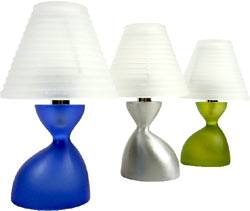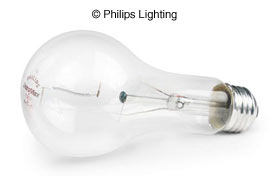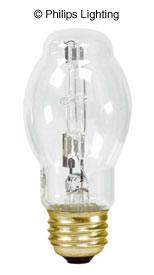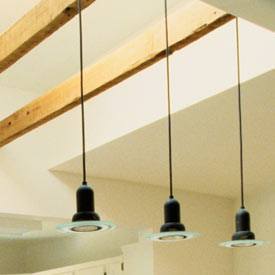
Many times good interior design counts on a certain kind of sleight-of-hand: The very best job is the one you don't notice, because it doesn't call attention to itself.
Good lighting, in a home or business, is one of those things that's invisible - if it's done well. You only notice the lighting of a room if it's too bright or too dim, not if it's just right. Our goal in offering this series of articles on Lighting is to give you some concrete advice on how to light a room so effectively that no one notices whether you're using florescent or incandescent lights, track lighting or standing lamps. They'll notice only that the room feels comfortable, and that they want to come back again.
In our Lighting 101 series, we've covered two of the most common types of lamps: Incandescent, the kind that produce soft light, and are used for most residential interiors, and fluorescent, which produce a harsher, brighter light and are more commonly used in industry, or in work spaces in a home, such as a garage or sewing room.
There is a third type of lamp that you should know about: Quartz-halogen lamps (pronounced HAL-oh-jin, with hal rhyming with pal.)
But before we go into the uses of these types of lamps, let's go over how a light bulb works, so that you'll have a clearer understanding of how this particular type of light functions and how it differs from a traditional incandescent lamps.
 First, how does an incandescent bulb work? As you know from replacing light bulbs, there is a large, thin, frosted glass envelope in the familiar light bulb shape. But what's inside? The interior of the bulb is filled with a gas, such as argon or nitrogen. Sitting in the center is a tungsten filament. When you turn on the light, the electricity heats up this filament — it gets as hot as 4,500 degrees Fahrenheit.
First, how does an incandescent bulb work? As you know from replacing light bulbs, there is a large, thin, frosted glass envelope in the familiar light bulb shape. But what's inside? The interior of the bulb is filled with a gas, such as argon or nitrogen. Sitting in the center is a tungsten filament. When you turn on the light, the electricity heats up this filament — it gets as hot as 4,500 degrees Fahrenheit.
This, in turn, emits light.
As we mentioned in the article on incandescent lights, and, as you know from your own experience replacing light bulbs over and over, these common light bulbs are not very efficient, lasting only 750 to 1,000 hours in normal use. One reason for this is that getting up to 4,500 Fahrenheit means the bulb radiates a huge amount of infrared heat — more heat than light. This heat is wasted; it isn't hot enough to warm a room, which is why you don't see anyone huddled around a lamp to keep warm.
The inefficiency of incandescent bulbs also means they don't last very long. That's because the tungsten in the filament gradually dissipates, and deposits on the glass, eventually forming a thin spot in the filament which causes it to break. That broken filament is what you hear when you shake a light bulb to see if it's burned out.

Now, what about a halogen lamp? This type of lamp also uses a tungsten filament, but instead of being in a light bulb-shaped envelope, it's in a much smaller quartz envelope. If you look at a quartz-halogen bulb, you'll see it doesn't have an incandescent lamp's distinctive bulb at the top. Instead, a quartz-halogen bulb's filament is much closer to the envelope, which, if it were made of thin glass, like a regular light bulb, would melt from the heat.
A quartz-halogen bulb also has a different type of gas inside, halogen. And — in a move that's bound to make you shout "eureka!" — halogen gas has a very interesting property: it combines with the vapor from the tungsten filament! As the tungsten heats, it emits vapors, and if the temperature is high enough, the halogen gas combines with the atoms in those vapors, re-depositing them on the filament.
This is a perfect example of recycling at its best: Because of this recycling, the filament in a quartz-halogen bulb lasts longer, and burns hotter, getting more light per unit of energy. 
All this work still produces a great deal of heat — and because the filament and the quartz envelope are so close, these bulbs are much, much hotter than a normal light bulb. You know, from all that light bulb changing you've done, that a bulb that's just burned out is hot to the touch; you have to wait a few seconds before you can unscrew it.
A quartz halogen bulb is much hotter than that — so hot that even if you can stand to touch it, the moisture and oils on your fingers can cause the hot glass to break. It's important to remember when replacing a quartz-halogen bulb, not to touch it with your bare hand.
Because of their small size and intense light, quartz-halogen lamps have been used by lamp designers in many industrial uses, such as for headlights of automobiles and in scientific research. But they're also useful in residential interiors, particularly in unusually-shaped modern fixtures. These fixtures take on the appearance of modern sculpture, and the unusual shapes of the bulbs allow light fixture designers free reign in creating interesting fixtures for quartz-halogen bulbs.
NYIAD Tip
For contemporary interiors, quartz-halogen lamps are often an excellent choice. In addition to providing bright lighting, their design can be dramatically modern. We recommend that, if you purchase such fixtures, you have them equipped with dimmers so that their blazingly bright light can be adjusted to appropriate levels.
One factor not to be ignored is cost, while halogen bulbs are more expensive than incandescent or fluorescent bulbs, they are more energy efficient, so you don't need to replace them as often.







